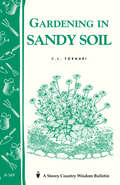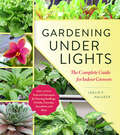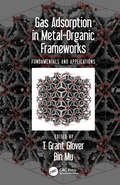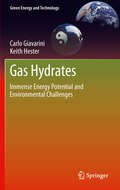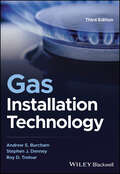- Table View
- List View
Gardening in Sandy Soil: Storey's Country Wisdom Bulletin A-169 (Storey Country Wisdom Bulletin)
by C. L. FornariSince 1973, Storey's Country Wisdom Bulletins have offered practical, hands-on instructions designed to help readers master dozens of country living skills quickly and easily. There are now more than 170 titles in this series, and their remarkable popularity reflects the common desire of country and city dwellers alike to cultivate personal independence in everyday life.
Gardening Under Lights: The Complete Guide for Indoor Growers
by Leslie F. HalleckA complete, practical manual for growing plants indoors.
Gardening with Emma: Grow and Have Fun: A Kid-to-Kid Guide
by Emma Biggs Steven BiggsEmma Biggs, an enthusiastic 13-year-old with a love of gardening, shares her just-for-kids advice on growing a food garden, including theme garden ideas and tips for preparing, planting, and caring for a garden, along with creative ways to have fun doing it.
Gardner's Commercially Important Chemicals: Synonyms, Trade Names, and Properties
by G. W. A. MilneAn exhaustive resource for the industrial chemical community Through eleven editions, Gardner's Chemical Synonyms and Trade Names has become the best-known and most widely used source of information on chemicals in commerce. This companion book reflects the continuing research underlying Gardner's and presents a major expansion of the information provided for individual chemical compounds. Gardner's Commercially Important Chemicals: Synonyms, Trade Names, and Properties: * Contains 4,174 chemical entries and information such as structure, molecular formula, and chemical name * Includes synonyms for each chemical, including other identifiers, chemical names, trade names, and trivial names, in English and other languages * Provides chemical properties of the compounds, information concerning known uses of the chemical and biological data-in particular, acute toxicity in various species, where available * Lists the companies that manufacture or supply the listed chemicals * Describes bulk inorganic chemicals, major pesticides (herbicides, insecticides, antifungal agents, etc.), and many dyestuffs, surfactants, and metals, along with the most commonly used drugs * Contains indexes by chemical name and synonym, Chemical Abstracts Service (CAS) Registry Numbers, and EINECS (European Inventory of Existing Commercial Substances) numbers One useful feature of this database is the inclusion of physical properties and use data for pure chemicals. Properties that have been provided, when available, include: the melting point, boiling point, density or specific gravity, optical rotation, ultraviolet absorption, solubility, and acute toxicity. The major uses of most of the chemicals are indicated and, where appropriate, regulatory information is also provided.
Gas Adsorption Equilibria: Experimental Methods and Adsorptive Isotherms
by Jürgen U. Keller Reiner StaudtThis book is intended to present for the first time experimental methods to measure equilibria states of pure and mixed gases being adsorbed on the surface of solid materials. It has been written for engineers and scientists from industry and academia who are interested in adsorption based gas separation processes and/or in using gas adsorption for characterization of the porosity of solid materials. This book is the result of a fruitful collaboration of a theoretician (JUK) and an experimentalist (RS) over more than twelve years in the field of gas adsorption systems at the Institute of Fluid- and Thermodynamics (IFT) at the University of Siegen, Siegen, Germany. This collaboration resulted in the development of several new methods to measure not only pure gas adsorption, but gas mixture or coadsorption equilibria on inert porous solids. Also several new theoretical results could be achieved leading to new types of so-called adsorption isotherms based on the concepts of molecular association and – phenomenologically speaking – on that of thermodynamic phases of fractal dimension. Naturally, results of international collaboration of the authors over the years (1980-2000) also are included.
Gas Adsorption in Metal-Organic Frameworks: Fundamentals and Applications
by T. Grant Glover Bin MuThis text discusses the synthesis, characterization, and application of metal-organic frameworks (MOFs) for the purpose of adsorbing gases. It provides details on the fundamentals of thermodynamics, mass transfer, and diffusion that are commonly required when evaluating MOF materials for gas separation and storage applications and includes a discussion of molecular simulation tools needed to examine gas adsorption in MOFs. Additionally, the work presents techniques that can be used to characterize MOFs after gas adsorption has occurred and provides guidance on the water stability of these materials. Lastly, applications of MOFs are considered with a discussion of how to measure the gas storage capacity of MOFs, a discussion of how to screen MOFs to for filtration applications, and a discussion of the use of MOFs to perform industrial separations, such as olefin/paraffin separations. Throughout the work, fundamental information, such as a discussion on the calculation of MOF surface area and description of adsorption phenomena in packed-beds, is balanced with a discussion of the results from research literature.
Gas Adsorption in Metal-Organic Frameworks: Fundamentals and Applications
by T. Grant Glover and Bin MuThis text discusses the synthesis, characterization, and application of metal-organic frameworks (MOFs) for the purpose of adsorbing gases. It provides details on the fundamentals of thermodynamics, mass transfer, and diffusion that are commonly required when evaluating MOF materials for gas separation and storage applications and includes a discussion of molecular simulation tools needed to examine gas adsorption in MOFs. Additionally, the work presents techniques that can be used to characterize MOFs after gas adsorption has occurred and provides guidance on the water stability of these materials. Lastly, applications of MOFs are considered with a discussion of how to measure the gas storage capacity of MOFs, a discussion of how to screen MOFs to for filtration applications, and a discussion of the use of MOFs to perform industrial separations, such as olefin/paraffin separations. Throughout the work, fundamental information, such as a discussion on the calculation of MOF surface area and description of adsorption phenomena in packed-beds, is balanced with a discussion of the results from research literature.
Gas Chromatography of Steroids in Biological Fluids: Proceedings of theWorkshop on Gas-Liquid Chromatography of Steroids in Biological Fluids
by Mortimer B. LipsettDuring the past decade we have witnessed a revolution in analytical methods. The development of vapor phase chromatography for the separation and analysis of classes of substances ranging from metals and gases to a wide variety of organic materials has been one of the most exciting of these new techniques. Gas-liquid chromatography for the measurement of steroids is particularly significant for endocrinologists and reports during the past several years have demonstrated its usefulness. Because of the growing interest in this method, a committee of the Endocrinology Study Section composed of Drs. R. M. Dodson, Seymour Lieberman, Hilton A. Salhanick, and Ralph E. Peterson, felt that the time was propitious to hold this Workshop and it is on their behalf that I welcome you. We hope to obtain enough data during these sessions so that those attending this conference and those who may read the proceedings will be able to make an informed judgement about the usefulness of gas-liquid chromatography for the analysis of steroids in biological fluids. Thus, I hope that there will be adequate documentation of the reliability of the methods as well as a comparison of the advantages and disadvantages of this analytical method with other classical methods. If we can do this, this Workshop will provide a significant base of practical considerations about gas chromatographic analytic techniques. I would like to thank Drs. T. F. Gallagher, H. Wilson, H. Salhanick and L. Engel for agreeing to serve as Chairmen of the sessions.
Gas Cleaning in Demanding Applications
by J. P. SevilleIn recent years, interest in the technology of gas cleaning has grown, driven partly by environmental legislation, but also by demands for increases in process efficiency and intensity - notable for power generation and waste incineration. This book, which leads on from our successful Gas Cleaning at High Temperatures, describes the present state of the art and its industrial applications.
Gas Cyclones and Swirl Tubes: Principles, Design, and Operation
by Alex C. Hoffmann Louis E. SteinThis book has been conceived to provide guidance on the theory and design of cyclone systems. Forthose new to the topic, a cyclone is, in its most basic form, a stationary mechanical device that utilizes centrifugal force to separate solid or liquid particles from a carrier gas. Gas enters near the top via a tangential or vaned inlet, which gives rise to an axially descending spiral of gas and a centrifugal force field that causes the incoming particles to concentrate along, and spiral down, the inner walls of the separator. The thus-segregated particulate phase is allowed to exit out an underflow pipe while the gas phase constricts, and - in most separators - reverses its axial direction of flow and exits out a separate overflow pipe. Cyclones are applied in both heavy and light industrial applications and may be designed as either classifiers or separators. Their applications are as plentiful as they are varied. Examples include their use in the separation or classification of powder coatings, plastic fines, sawdust, wood chips, sand, sintered/powdered meta!, plastic and meta! pellets, rock and mineral cmshings, carbon fines, grain products, pulverized coal, chalk, coal and coal ash, catalyst and petroleum coke fines, mist entrained off of various processing units and liquid components from scmbbing and drilling operations. They have even been applied to separate foam into its component gas and liquid phases in recent years.
Gas Cyclones and Swirl Tubes: Principles, Design, and Operation
by Alex C. Hoffmann Louis E. SteinBelieved to be a publishing first when originally brought out, this book covers all aspects of centrifugal gas cleaning devices. These are cyclones used as gas-solid separators for dedusting and as gas-liquid separators for demisting. The optimization of cyclone performance for any given task is a sought-after goal – but it is one that is seldom achieved in practice. This second edition will help mechanical and chemical engineers to achieve this optimization.
Gas Discharge and Gas Insulation (Energy and Environment Research in China #6)
by Dengming XiaoThis book presents a comprehensive overview of research on environmentally friendly insulating gases, in response to the urgent calls for developing alternatives to SF6 due to the increasing awareness of the threat it poses as a greenhouse gas. It covers gas dielectrics, SF6 and its mixtures, and potential alternative gases, providing fundamental information on gas discharge and gas insulation and especially focusing on the development of new environmentally friendly insulating gases over the last decade. The book begins by describing the insulating and arcing characteristics of SF6, followed by an introduction to the gas dielectrics performance of SF6 gas mixtures with buffer gases. The latest findings on new environmentally friendly insulating gases are described in detail, and suggestions for practical application are also provided. Graduate students and teachers involved in high-voltage and insulation engineering can use the book as teaching material. Researchers working in plasma science, laser action and related applied physics fields can also benefit from the book’s analytical approach and detailed data; engineers from the fields of electric power operation systems and electrical manufacturing will find it a valuable reference work for solving practical problems.
Gas Discharge Closing Switches (Advances in Pulsed Power Technology #2)
by Gerhard Schaefer M. Kristiansen A. H. GuentherPulsed power technology, in the simplest of terms, usually concerns the storage of electrical energy over relatively long times and then its rapid release over a comparatively short period. However, if we leave the definition at that, we miss a multitude of aspects that are important in the ultimate application of pulsed power. It is, in fact, the application of pulsed power technology to which this series of texts will be focused. Pulsed power in today's broader sense means "special power" as opposed to the tra ditional situation of high voltage impulse issues related to the utility industry. Since the pulsed power field is primarily application driven, it has principally an engineering flavor. Today' s applications span those from materials processing, such as metal forming by pulsed magnetic fields, to other varied applications, such as psy chedelic strobe lights or radar modulators. Very high peak power applications occur in research for inertial confinement fusion, the Strategic Defense Initiative and other historical defense uses. lri fact it is from this latter direction that pulsed power has real ized explosive growth over the past half century. Early thrusts were in electrically powered systems that simulated the environment or effects of nuclear weapons detonation. More recently it is being utilized as prime power sources for directed energy weapons, such as lasers, microwaves, particle beam weapons, and even mass drivers (kinetic energy weapons).
Gas Explosion Technology and Biomass Refinery
by Hongzhang ChenThe book introduces gas explosion technology (GET) and its applications in biomass refineries. In this book an overview of GET is provided, the mechanisms are thoroughly discussed. The chapters also cover the latest processes and equipments of GET, including equipment selection, parameter determination and engineering scaling-up. Last but not least the applications of GET are introduced in details. It is an excellent reference and guidance for scientists engaging in the research of biomass and biotechnology. Professor Hongzhang Chen is the Vice Director and Supervisor of the State Key Laboratory of Biochemical Engineering at the Institute of Process Engineering of the Chinese Academy of Sciences.
Gas Hydrate in Carbon Capture, Transportation and Storage: Technological, Economic, and Environmental Aspects
by Bhajan Lal Anipeddi ManjushaThis book offers a deep insight into gas hydrate-based carbon capture, transportation, and storage technology as a solution to decarbonization. The key aspects of carbon capture & storage technologies are discussed together with their advantages and status of development and commercialization. The authors delve into intricacies of gas hydrate reactor design, provide a review on the Techno-Economic Aspects (TEA), expound critical safety considerations and elucidate upon the regulatory mandates shaping the landscape of decarbonization initiatives.Gas Hydrate in Carbon Capture, Transportation and Storage: Technological, Economic, and Environmental Aspects is an essential resource for all academicians, researchers, flow assurance engineers, industry professionals and students working in this field.
Gas Hydrate in Carbon Capture, Transportation and Storage: Technological, Economic, and Environmental Aspects
This book offers a deep insight into gas hydrate-based carbon capture, transportation, and storage technology as a solution to decarbonization. The key aspects of carbon capture & storage technologies are discussed together with their advantages and status of development and commercialization. The authors delve into intricacies of gas hydrate reactor design, provide a review on the Techno-Economic Aspects (TEA), expound critical safety considerations and elucidate upon the regulatory mandates shaping the landscape of decarbonization initiatives.Gas Hydrate in Carbon Capture, Transportation and Storage: Technological, Economic, and Environmental Aspects is an essential resource for all academicians, researchers, flow assurance engineers, industry professionals and students working in this field.
Gas Hydrates: Immense Energy Potential and Environmental Challenges (Green Energy and Technology)
by Carlo Giavarini Keith HesterGas hydrates are both a huge energy resource and an environmental challenge. They have a significant impact on society because of their applications to the future of energy, protection of the environment and fuel transportation.Gas Hydrates opens up this fascinating, multidisciplinary field to non-specialists. It provides a scientific study of gas hydrates that considers their potential as an energy source while assessing the possible risk to the environment. The authors also examine the feasibility of using these natural compounds for storing and transporting gases such as methane and carbon dioxide. Diagrams and photos are used throughout Gas Hydrates to help readers understand the scientific and technical content. Each section has been designed so it can be read independently by academics and professionals in the oil and gas industry, as well as by all those with an interest in how hydrates combine to be an energy resource, an industrial challange and a geological hazard.
Gas Installation Technology
by Andrew S. Burcham Stephen J. Denney Roy D. TreloarUnderstand the core competencies of gas installation with this accessible textbook Gas operatives in the UK must be Gas Safe registered, suitably qualified and assessed as competent in the aspect of gas work that they wish to undertake. Qualification is gained by means of an industry recognised Managed Learning Programme or a gas aligned National Vocational Qualification (NVQ/SNVQ). Periodic renewal thereafter is by means of the National Accredited Certification Scheme (ACS). Gas Installation Technology is the definitive textbook for students enrolled in any of these courses. Now fully updated to reflect new standards and the most up to date best practices, it remains the indispensable reference for anyone working in the gas industry. Readers of the third edition of Gas Installation Technology will also find: Coverage of commercial, domestic, and LPG installations New or updated material on ‘net zero’ targets, climate change, and other aspects of the gas industry’s future Notes and examples within each chapter to facilitate learningGas Installation Technology is ideal for students in gas installation or plumbing courses, as well as for professional gas installers renewing their certification.
Gas Installation Technology
by Andrew S. Burcham Stephen J. Denney Roy D. TreloarUnderstand the core competencies of gas installation with this accessible textbook Gas operatives in the UK must be Gas Safe registered, suitably qualified and assessed as competent in the aspect of gas work that they wish to undertake. Qualification is gained by means of an industry recognised Managed Learning Programme or a gas aligned National Vocational Qualification (NVQ/SNVQ). Periodic renewal thereafter is by means of the National Accredited Certification Scheme (ACS). Gas Installation Technology is the definitive textbook for students enrolled in any of these courses. Now fully updated to reflect new standards and the most up to date best practices, it remains the indispensable reference for anyone working in the gas industry. Readers of the third edition of Gas Installation Technology will find: Coverage of commercial, domestic, and LPG installations New or updated material on 'net zero' targets, climate change, and other aspects of the gas industry's future Notes and examples within each chapter to facilitate learning Gas Installation Technology is ideal for students in gas installation or plumbing courses, as well as for professional gas installers renewing their certification. Coverage of commercial, domestic, and LPG installations New or updated material on 'net zero' targets, climate change, and other aspects of the gas industry's future Notes and examples within each chapter to facilitate learning
Gas Installation Technology
by R. D. TreloarThe second edition of Gas Installation Technology will be of interest to all concerned with gas installation work, whether plumbers, heating engineers or dedicated gas fitters. It continues to provide a definitive text for students taking NVQ gas installation and plumbing courses, and a useful reference for operatives renewing their gas competences. Brought fully up to date to comply with the latest regulations and best practices, it covers domestic, commercial and LPG installations, and provides essential information in a concise, readable, colourful and highly illustrated format. The new edition features enhanced diagrams and photographs to aid understanding. The second edition of Gas Installation Technology continues to be a companion to the author’s highly successful textbook, Plumbing, and together both books offer plumbers, heating engineers and gas fitters, or students of these disciplines, unrivalled coverage of their subject. Fully revised to cover the latest legislation, best practices and current installation procedures, it covers domestic, commercial and LPG installations Still the only textbook devoted to domestic gas, commercial gas and LPG installation Concise and readable, heavily illustrated with colour diagrams and photographs to aid understanding and recall
Gas Installation Technology
by R. D. TreloarThis book provides the definitive text for students taking NVQ gas installation and plumbing courses. It presents essential information in a concise format and the text is well illustrated with diagrams and photographs. It should provide the first textbook aimed solely at students learning the subject of gas and follows the same approach as Roy Treloar's highly successful textbook, Plumbing. It covers domestic, commercial and LPG installations.
Gas Insulated Substations (Wiley - IEEE)
by Hermann J. KochComprehensive reference covering all aspects of gas insulated substations including basic principles, technology, use & application, design, specification, testing and ownership issues This book provides an overview on the particular development steps of gas insulated high-voltage switchgear, and is based on the information given with the editor’s tutorial. The theory is kept low only as much as it is needed to understand gas insulated technology, with the main focus of the book being on delivering practical application knowledge. It discusses some introductory and advanced aspects in the meaning of applications. The start of the book presents the theory of Gas Insulated Technology, and outlines reliability, design, safety, grounding and bonding, and factors for choosing GIS. The third chapter presents the technology, covering the following in detail: manufacturing, specification, instrument transformers, Gas Insulated Bus, and the assembly process. Next, the book goes into control and monitoring, which covers local control cabinet, bay controller, control schemes, and digital communication. Testing is explained in the middle of the book before installation and energization. Importantly, operation and maintenance is discussed. This chapter includes information on repair, extensions, retrofit or upgrade, and overloading. Finally applications are covered along with concepts of layout, typical layouts, mixed technology substations, and then other topics such as life cycle assessment, environmental impact, and project management. A one-stop, complete reference text on gas insulated substations (GIS), large-capacity and long-distance electricity transmission, which are of increasing importance in the power industry today Details advanced and basic material, accessible for both existing GIS users and those planning to adopt the technology Discusses both the practical and theoretical aspects of GIS Written by acknowledged GIS experts who have been involved in the development of the technology from the start
Gas Insulated Substations (Wiley - IEEE)
by Hermann J. KochComprehensive reference covering all aspects of gas insulated substations including basic principles, technology, use & application, design, specification, testing and ownership issues This book provides an overview on the particular development steps of gas insulated high-voltage switchgear, and is based on the information given with the editor’s tutorial. The theory is kept low only as much as it is needed to understand gas insulated technology, with the main focus of the book being on delivering practical application knowledge. It discusses some introductory and advanced aspects in the meaning of applications. The start of the book presents the theory of Gas Insulated Technology, and outlines reliability, design, safety, grounding and bonding, and factors for choosing GIS. The third chapter presents the technology, covering the following in detail: manufacturing, specification, instrument transformers, Gas Insulated Bus, and the assembly process. Next, the book goes into control and monitoring, which covers local control cabinet, bay controller, control schemes, and digital communication. Testing is explained in the middle of the book before installation and energization. Importantly, operation and maintenance is discussed. This chapter includes information on repair, extensions, retrofit or upgrade, and overloading. Finally applications are covered along with concepts of layout, typical layouts, mixed technology substations, and then other topics such as life cycle assessment, environmental impact, and project management. A one-stop, complete reference text on gas insulated substations (GIS), large-capacity and long-distance electricity transmission, which are of increasing importance in the power industry today Details advanced and basic material, accessible for both existing GIS users and those planning to adopt the technology Discusses both the practical and theoretical aspects of GIS Written by acknowledged GIS experts who have been involved in the development of the technology from the start
Gas Insulated Substations (IEEE Press)
by Hermann J. KochGAS INSULATED SUBSTATIONS An essential reference guide to gas-insulated substations The second edition of Gas Insulated Substations (GIS) is an all-inclusive reference guide to gas insulated substations (GIS) and its advanced technologies. Updated to the latest technical developments and applications, the guide covers basic physics of gas insulated systems, SF6 insulating gas and its alternatives, safety aspects and factors to choose GIS. GIS technology, its modular structure, control and monitoring systems, testing, installation rules and guidelines for operation, specification, and maintenance. Detailed information on various types for GIS, with 14 reference project explanations and three extensive case studies give information for the best solutions of practical applications. Special solutions using mobile substations concepts, mixed technology switchgear (MTS) with air and gas insulated technology, underground substations, and the use of special GIS substation buildings e.g., shopping centers, parking lots, city parks, business complexes’ or subway stations are explained. Future developments of GIS technology are shown for the next steps in alternatives to SF6, low power instrument transformers, and digitalization of substations. A new chapter explains advanced technologies applied to GIS projects which cover the following; environmental issues for the substation permission process, insulation coordination studies for the network requirements including very fast transients, project scope development, risk-based asset management, health and safety impact, electromagnetic fields, SF6 decomposition byproducts and condition assessment. Disruptive development steps in gas insulated substations technologies are also covered in this second edition. Vacuum breaking and switching technology for rated voltages of up to 500 kV is explained in detail with its physical background. Principle function and possible implementation of low power instrument transformers (LPIT) are explained and examples of applications are given. The principles of digital twin for gas insulated substations (GIS) and gas insulated transmission lines (GIL) are explained in theory and project applications show the practical use and advantage. The wide and fast-growing technical field of offshore GIS applications for AC and DC is explained on many examples and gives information on special requirements when getting offshore. Theoretical requirements on DC gas insulated systems, methods of testing, prototype installation tests, modular design features, and advantages in applications are given. Finally, impact and advantages of digital substations using GIS are explained. Key features: Written by leading GIS experts involved in development and project applications Discusses practical and theoretical aspects Detailed material of GIS for new and experienced GIS users, and project planners Invaluable guide to practicing electrical, mechanical and civil engineers as well as third- and fourth-year electric power engineering students
Gas Insulated Substations (IEEE Press)
by Hermann J. KochGAS INSULATED SUBSTATIONS An essential reference guide to gas-insulated substations The second edition of Gas Insulated Substations (GIS) is an all-inclusive reference guide to gas insulated substations (GIS) and its advanced technologies. Updated to the latest technical developments and applications, the guide covers basic physics of gas insulated systems, SF6 insulating gas and its alternatives, safety aspects and factors to choose GIS. GIS technology, its modular structure, control and monitoring systems, testing, installation rules and guidelines for operation, specification, and maintenance. Detailed information on various types for GIS, with 14 reference project explanations and three extensive case studies give information for the best solutions of practical applications. Special solutions using mobile substations concepts, mixed technology switchgear (MTS) with air and gas insulated technology, underground substations, and the use of special GIS substation buildings e.g., shopping centers, parking lots, city parks, business complexes’ or subway stations are explained. Future developments of GIS technology are shown for the next steps in alternatives to SF6, low power instrument transformers, and digitalization of substations. A new chapter explains advanced technologies applied to GIS projects which cover the following; environmental issues for the substation permission process, insulation coordination studies for the network requirements including very fast transients, project scope development, risk-based asset management, health and safety impact, electromagnetic fields, SF6 decomposition byproducts and condition assessment. Disruptive development steps in gas insulated substations technologies are also covered in this second edition. Vacuum breaking and switching technology for rated voltages of up to 500 kV is explained in detail with its physical background. Principle function and possible implementation of low power instrument transformers (LPIT) are explained and examples of applications are given. The principles of digital twin for gas insulated substations (GIS) and gas insulated transmission lines (GIL) are explained in theory and project applications show the practical use and advantage. The wide and fast-growing technical field of offshore GIS applications for AC and DC is explained on many examples and gives information on special requirements when getting offshore. Theoretical requirements on DC gas insulated systems, methods of testing, prototype installation tests, modular design features, and advantages in applications are given. Finally, impact and advantages of digital substations using GIS are explained. Key features: Written by leading GIS experts involved in development and project applications Discusses practical and theoretical aspects Detailed material of GIS for new and experienced GIS users, and project planners Invaluable guide to practicing electrical, mechanical and civil engineers as well as third- and fourth-year electric power engineering students
